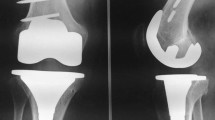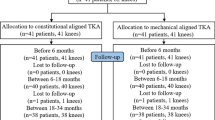Abstract
Purpose
In a retrospective comparative analysis in patients undergoing primary guided-motion total knee arthroplasty (TKA), the authors have evaluated whether different TKA implant design would influence the clinical and functional outcomes.
Methods
Between 2007 and 2009, 227 computer-assisted primary TKAs were performed in 219 consecutive patients. Patients received one of the two different fixed-bearing guided-motion TKA designs assisted by navigation surgery: the Scorpio Non-Restrictive Geometry (NRG) knee system and the Journey Bi-Cruciate Stabilized (BCS) knee systems.
Results
Data were available for 180 patients (187 knees). No significant differences were observed between the two groups with respect to preoperative demographic characteristics, range of motion (ROM) and radiographic knee alignment. At a mean follow-up of 29 months, the Journey BCS group had higher mean Knee Injury and Osteoarthritis Outcome Score (KOOS) in all subscales and a greater ROM than the Scorpio NRG group. This difference was statistically significant for the KOOS subscales of pain (p = 0.007) and knee-related quality of life (p = 0.045), as well as for postoperative ROM (p = 0.018). Considering the overall complications, 1 patient of Scorpio NRG group (0.5 %) and 5 in Journey BCS (2.7 %) had stiffness. Anterior knee pain was reported in 4 cases of Scorpio NRG group (2.1 %). In the Journey BCS group were observed 2 cases (1.1 %) of frontal plane instability and 1 case (0.5 %) of synovitis pain.
Conclusions
The bearing geometry and kinematic pattern of different guided-motion prosthetic designs can affect the clinical–functional outcome and complications type in primary TKA.
Level of evidence
Clinical study, Level III.



Similar content being viewed by others
References
Argenson JN, Parratte S, Ashour A, Komistek RD, Scuderi GR (2008) Patient-reported outcome correlates with knee function after a single-design mobile-bearing TKA. Clin Orthop Relat Res 466:2669–2676
Bellemans J, Banks S, Victor J, Vandenneucker H, Moemans A (2002) Fluoroscopic analysis of the kinematics of deep flexion in total knee arthroplasty. Influence of posterior condylar offset. J Bone Joint Surg Br 84:50–53
Blakeney WJ, Khan JK, Wall SJ (2011) Computer-assisted techniques versus conventional guides for component alignment in total knee arthroplasty. a randomized trial. J Bone Joint Surg Am 93:1377–1384
Boldt JG, Stiehl JB, Hodler J, Zanetti M, Munzinger U (2006) Femoral component rotation and arthrofibrosis following mobile-bearing total knee arthroplasty. Int Orthop 30:420–425
Borrione F, Bonnevialle P, Mabit C, Guingand O, Bertin D, Bonnomet F, Denis C, Gagna G (2011) Scorpio single radius total knee arthroplasty. A minimal five-year follow-up multicentric study. Int Orthop 35:1777–1782
Bourne RB, Chesworth BM, Davis AM, Mahomed NN, Charron KD (2010) Patient satisfaction after total knee arthroplasty: who is satisfied and who is not? Clin Orthop Relat Res 468:57–63
Brosseau L, Tousignant M, Budd J, Chartier N, Duciaume L, Plamondon S, O’Sullivan JP, O’Donoghue S, Balmer S (1997) Intratester and intertester reliability and criterion validity of the parallelogram and universal goniometers for active knee flexion in healthy subjects. Physiother Res Int 2:150–166
Catani F, Biasca N, Ensini A, Leardini A, Bianchi L, Digennaro V, Giannini S (2008) Alignment deviation between bone resection and final implant positioning in computer-navigated total knee arthroplasty. J Bone Joint Surg Am 90:765–771
Catani F, Innocenti B, Belvedere C, Labey L, Ensini A, Leardini A (2010) The Mark Coventry Award: Articular contact estimation in TKA using in vivo kinematics and finite element analysis. Clin Orthop Relat Res 468:19–28
Choi WC, Lee S, Seong SC, Jung JH, Lee MC (2010) Comparison between standard and high-flexion posterior-stabilized rotating-platform mobile-bearing total knee arthroplasties: a randomized controlled study. J Bone Joint Surg Am 92:2634–2642
Churchill DL, Incavo SJ, Johnson CC, Beynnon BD (1998) The transepicondylar axis approximates the optimal flexion axis of the knee. Clin Orthop Relat Res 356:111–118
Dennis DA, Komistek RD, Mahfouz MR, Haas BD, Stiehl JB (2003) Multicenter determination of in vivo kinematics after total knee arthroplasty. Clin Orthop Relat Res 416:37–57
Dennis DA, Komistek RD, Mahfouz MR, Walker SA, Tucker A (2004) A multicenter analysis of axial femorotibial rotation after total knee arthroplasty. Clin Orthop Relat Res 428:180–189
Edwards JZ, Greene KA, Davis RS, Kovacik MW, Noe DA, Askew MJ (2004) Measuring flexion in knee arthroplasty patients. J Arthroplasty 19:369–372
Ensini A, Catani F, Leardini A, Romagnoli M, Giannini S (2007) Alignments and clinical results in conventional and navigated total knee arthroplasty. Clin Orthop Relat Res 457:156–162
Fukunaga K, Kobayashi A, Minoda Y, Iwaki H, Hashimoto Y, Takaoka K (2009) The incidence of the patellar clunk syndrome in a recently designed mobile-bearing posteriorly stabilised total knee replacement. J Bone Joint Surg Br 91:463–468
Gioe TJ, Glynn J, Sembrano J, Suthers K, Santos ER, Singh J (2009) Mobile and fixed-bearing (all-polyethylene tibial component) total knee arthroplasty designs. A prospective randomized trial. J Bone Joint Surg Am 91:2104–2112
Gomez-Barrena E, Fernandez-Garcia C, Fernandez-Bravo A, Cutillas-Ruiz R, Bermejo-Fernandez G (2010) Functional performance with a single-radius femoral design total knee arthroplasty. Clin Orthop Relat Res 468:1214–1220
Gunston FH (1971) Polycentric knee arthroplasty. Prosthetic simulation of normal knee movement. J Bone Joint Surg Br 53:272–277
Hoffart HE, Langenstein E, Vasak N (2012) A prospective study comparing the functional outcome of computer-assisted and conventional total knee replacement. J Bone Joint Surg Br 94:194–199
Hollister AM, Jatana S, Singh AK, Sullivan WW, Lupichuk AG (1993) The axes of rotation of the knee. Clin Orthop Relat Res 290:259–268
Insall JN, Lachiewicz PF, Burstein AH (1982) The posterior stabilized condylar prosthesis: a modification of the total condylar design. Two to four-year clinical experience. J Bone Joint Surg Am 64:1317–1323
Ip D, Wu WC, Tsang WL (2002) Comparison of two total knee prostheses on the incidence of patella clunk syndrome. Int Orthop 26:48–51
Ip D, Ko PS, Lee OB, Wu WC, Lam JJ (2004) Natural history and pathogenesis of the patella clunk syndrome. Arch Orthop Trauma Surg 124:597–602
Jenny JY, Boeri C, Picard F, Leitner F (2004) Reproducibility of intra-operative measurement of the mechanical axes of the lower limb during total knee replacement with a non-image-based navigation system. Comput Aided Surg 9:161–165
Kessler O, Durselen L, Banks S, Mannel H, Marin F (2007) Sagittal curvature of total knee replacements predicts in vivo kinematics. Clin Biomech (Bristol, Avon) 22:52–58
Khan MM, Khan MW, Al-Harbi HH, Weening BS, Zalzal PK (2012) Assessing short-term functional outcomes and knee alignment of computer-assisted navigated total knee arthroplasty. J Arthroplasty 27:271–277
Kim J, Nelson CL, Lotke PA (2004) Stiffness after total knee arthroplasty. Prevalence of the complication and outcomes of revision. J Bone Joint Surg Am 86:1479–1484
Lachiewicz PF, Soileau ES (2004) The rates of osteolysis and loosening associated with a modular posterior stabilized knee replacement. Results at five to fourteen years. J Bone Joint Surg Am 86:525–530
Lingard EA, Katz JN, Wright RJ, Wright EA, Sledge CB (2001) Validity and responsiveness of the Knee Society Clinical Rating System in comparison with the SF-36 and WOMAC. J Bone Joint Surg Am 83:1856–1864
Lingard EA, Katz JN, Wright EA, Sledge CB (2004) Predicting the outcome of total knee arthroplasty. J Bone Joint Surg Am 86:2179–2186
Lonner JH, Jasko JG, Bezwada HP, Nazarian DG, Booth RE Jr (2007) Incidence of patellar clunk with a modern posterior-stabilized knee design. Am J Orthop (Belle Mead NJ) 36:550–553
Maloney WJ, Schmidt R, Sculco TP (2003) Femoral component design and patellar clunk syndrome. Clin Orthop Relat Res 410:199–202
Malviya A, Lingard EA, Weir DJ, Deehan DJ (2009) Predicting range of movement after knee replacement: the importance of posterior condylar offset and tibial slope. Knee Surg Sports Traumatol Arthrosc 17:491–498
Marx RG, Grimm P, Lillemoe KA, Robertson CM, Ayeni OR, Lyman S, Bogner EA, Pavlov H (2011) Reliability of lower extremity alignment measurement using radiographs and PACS. Knee Surg Sports Traumatol Arthrosc 19:1693–1698
Massin P, Gournay A (2006) Optimization of the posterior condylar offset, tibial slope, and condylar roll-back in total knee arthroplasty. J Arthroplasty 21:889–896
Monticone M, Ferrante S, Salvaderi S, Rocca B, Totti V, Foti C, Roi GS (2012) Development of the Italian version of the knee injury and osteoarthritis outcome score for patients with knee injuries: cross-cultural adaptation, dimensionality, reliability, and validity. Osteoarthr Cartilage 20:330–335
Nilsdotter AK, Toksvig-Larsen S, Roos EM (2009) Knee arthroplasty: are patients’ expectations fulfilled? A prospective study of pain and function in 102 patients with 5-year follow-up. Acta Orthop 80:55–61
Padua R, Ceccarelli E, Bondi R, Campi A, Padua L (2007) Range of motion correlates with patient perception of TKA outcome. Clin Orthop Relat Res 460:174–177
Pitto RP, Graydon AJ, Bradley L, Malak SF, Walker CG, Anderson IA (2006) Accuracy of a computer-assisted navigation system for total knee replacement. J Bone Joint Surg Br 88:601–605
Roos EM, Roos HP, Lohmander LS, Ekdahl C, Beynnon BD (1998) Knee injury and osteoarthritis outcome score (KOOS)–development of a self-administered outcome measure. J Orthop Sports Phys Ther 28:88–96
Roos EM, Toksvig-Larsen S (2003) Knee injury and osteoarthritis outcome score (KOOS)—validation and comparison to the WOMAC in total knee replacement. Health Qual Life Outcomes 1:17
Rubinstein RA Jr, DeHaan A (2010) The incidence and results of manipulation after primary total knee arthroplasty. Knee 17:29–32
Seon JK, Park SJ, Lee KB, Li G, Kozanek M, Song EK (2009) Functional comparison of total knee arthroplasty performed with and without a navigation system. Int Orthop 33:987–990
Spencer JM, Chauhan SK, Sloan K, Taylor A, Beaver RJ (2007) Computer navigation versus conventional total knee replacement: no difference in functional results at two years. J Bone Joint Surg Br 89:477–480
Tamaki M, Tomita T, Watanabe T, Yamazaki T, Yoshikawa H, Sugamoto K (2009) In vivo kinematic analysis of a high-flexion, posterior-stabilized, mobile-bearing knee prosthesis in deep knee bending motion. J Arthroplasty 24:972–978
Tayot O, Ait Si Selmi T, Neyret P (2001) Results at 11.5 years of a series of 376 posterior stabilized HLS1 total knee replacements. Survivorship analysis, and risk factors for failure. Knee 8:195–205
Thadani PJ, Vince KG, Ortaaslan SG, Blackburn DC, Cudiamat CV (2000) Ten- to 12-year followup of the Insall-Burstein I total knee prosthesis. Clin Orthop Relat Res 380:17–29
Victor J, Hoste D (2004) Image-based computer-assisted total knee arthroplasty leads to lower variability in coronal alignment. Clin Orthop Relat Res 428:131–139
Wang H, Simpson KJ, Chamnongkich S, Kinsey T, Mahoney OM (2005) A biomechanical comparison between the single-axis and multi-axis total knee arthroplasty systems for the stand-to-sit movement. Clin Biomech (Bristol, Avon) 20:428–433
Yercan HS, Sugun TS, Bussiere C, Ait Si Selmi T, Davies A, Neyret P (2006) Stiffness after total knee arthroplasty: prevalence, management and outcomes. Knee 13:111–117
Zmistowski B, Restrepo C, Kahl LK, Parvizi J, Sharkey PF (2011) Incidence and reasons for nonrevision reoperation after total knee arthroplasty. Clin Orthop Relat Res 469:138–145
Acknowledgments
The authors would like to thank Fennema Peter for his review of an earlier version of this work, with constructive criticism, and for English language editing. Also, we would like to express gratitude to Claudio Belvedere for his contribution in the statistical analysis.
Conflict of interest
All the authors declare that they have no conflict of interest.
Author information
Authors and Affiliations
Corresponding author
Rights and permissions
About this article
Cite this article
Mugnai, R., Digennaro, V., Ensini, A. et al. Can TKA design affect the clinical outcome? Comparison between two guided-motion systems. Knee Surg Sports Traumatol Arthrosc 22, 581–589 (2014). https://doi.org/10.1007/s00167-013-2509-9
Received:
Accepted:
Published:
Issue Date:
DOI: https://doi.org/10.1007/s00167-013-2509-9




